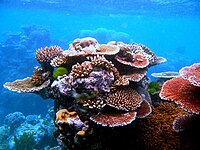
Photo from wikipedia
Vibrio coralliilyticus is known to cause coral diseases, especially under environmental perturbation, but its impact on coral physiology and underpinning mechanism is poorly understood. In the present study, we investigated… Click to show full abstract
Vibrio coralliilyticus is known to cause coral diseases, especially under environmental perturbation, but its impact on coral physiology and underpinning mechanism is poorly understood. In the present study, we investigated cytological, immunological, and metatranscriptomic responses of the scleractinian coral Pocillopora damicornis to V. coralliilyticus infection. The density and chlorophyll content of symbiotic zooxanthellae decreased significantly at 12 and 24 h after Vibrio challenge. The activities of antioxidant enzymes such as superoxide dismutase and catalase, nitric oxide synthase, phenoloxidase (PO), and the activation level of caspase3 all rose significantly in P. damicornis after Vibrio challenge. In the metatranscriptomic analysis, we found 10 significantly upregulated genes in the symbionts at 24 h after the challenge, which were mostly involved in the metabolism of nucleic acid and polysaccharide, and 133 significantly down-regulated symbiont genes, which were mainly related to amino acid catabolism and transport. Meanwhile, 1432 significantly upregulated coral genes were revealed, highly overrepresented in GO terms that are mostly related to the regulation of immune response, the regulation of cytokine production, and innate immune response. Furthermore, at 24 h after Vibrio challenge, 890 coral genes were significantly downregulated, highly overrepresented in four GO terms implicated in defense response. These results in concert suggest that V. coralliilyticus infection triggered the innate immune response including the redox, PO, and apoptosis systems, but repressed the response of the complement system in the scleractinian coral P. damicornis, accompanied by symbiont density decrease and symbiosis collapse through disordering the metabolism of the symbionts. These findings shed light on the molecular regulatory processes underlying bleaching and degradation of P. damicornis resulting from the infection of V. coralliilyticus.
Journal Title: Frontiers in Physiology
Year Published: 2019
Link to full text (if available)
Share on Social Media: Sign Up to like & get
recommendations!